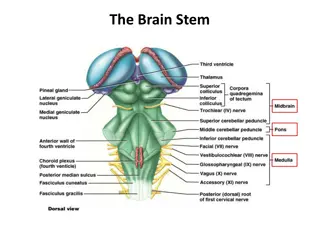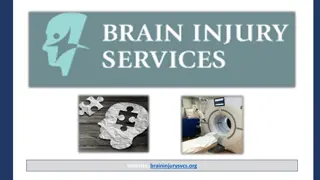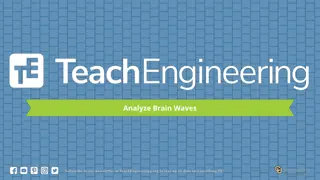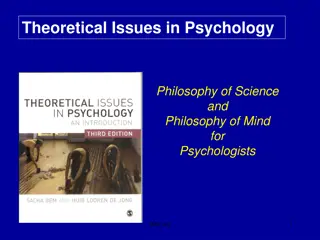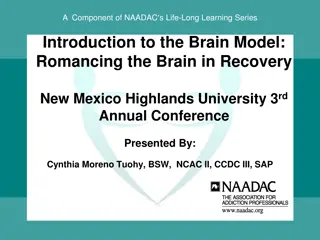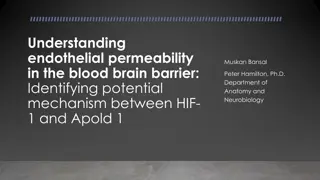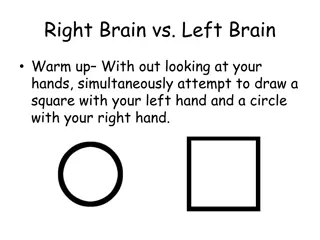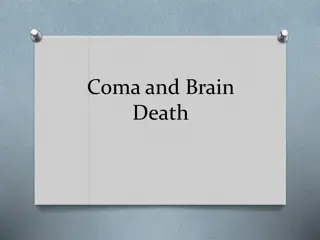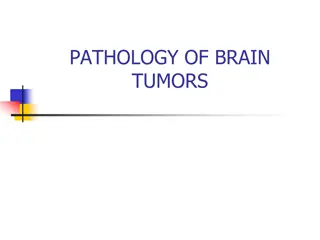Mind-Brain Identity Theory Overview
Explore Mind-Brain Identity Theory summarily covering its key concepts, criticisms, supporting arguments, and common misunderstandings. Delve into ontological and analytical reducibility aspects.
Download Presentation

Please find below an Image/Link to download the presentation.
The content on the website is provided AS IS for your information and personal use only. It may not be sold, licensed, or shared on other websites without obtaining consent from the author.If you encounter any issues during the download, it is possible that the publisher has removed the file from their server.
You are allowed to download the files provided on this website for personal or commercial use, subject to the condition that they are used lawfully. All files are the property of their respective owners.
The content on the website is provided AS IS for your information and personal use only. It may not be sold, licensed, or shared on other websites without obtaining consent from the author.
E N D
Presentation Transcript
Analytically or Ontologically Reducible? Analytically or Ontologically Reducible? 1. Lightning / Electrical Discharge 2. Triangles / Three Sided Shape 3. Mike Harvey / Awesome Philosophy Teacher 4. Sun / Burning ball of gas 5. Widow / Lady whose husband has passed away 6. Heart / Organ that pumps blood round your body 7. Bachelor / Unmarried man 8. Christmas Day / 25thDecember
Identity Theory Identity Theory Summarise what you can remember about Mind- Brain Identity Theory in 20 words or less on your whiteboards. Try to cover as much of the theory as possible in your summary.
Homework For This Lesson 1. Outline the divisibility argument and explain one criticism. 2. Outline the P-Zombie argument and explain one criticism. 3. Outline the problem of interaction and explain how Descartes attempts to respond to this.
Even Shorter Summary: Key Thinkers: J.J.C. Smart Mind and Brain are identical (they share all the same attributes Leibniz s Law). Accordingly any talk of mental states is actually just referring to particular events in the brain. Mental states are therefore ontologically reducible to brain states. However the language of mental states has different meanings and purposes than the language of brain states - we can t simply replace one with the other. They are not analytically reducible.
Arguments Supporting MBTIT Arguments Supporting MBTIT What arguments did we cover in support of Mind-Brain Identity Theory? Why might people think it is an effective theory of mind? 1. What can physicalism offer that dualism struggles with? Give specific examples 2. Why does current scientific knowledge support identity theory? 3. What are nomological danglers? Why are they an issue for dualism? Why does Ockham s Razor apply here? 4. What issues of dualism and does identity theory solve? 5. Why does identity theory not necessarily need philosophical arguments to prove it correct?
What mistake is the writer making What mistake is the writer making here? here? Identity theory is implausible since the words we use to talk about our mental states and processes do not mean the same as our vocabulary of physical states and processes occurring in the brain. When I say that I fancy a drink, I do not mean my brain is in a certain state. Similarly, if instead of saying that I have a headache I say that a certain neural pathway is being activated, don t I lose something in the translation? Surely talking about neural pathways being activated is not the same thing as saying I have a headache.
Common Mistake: Analytically vs Common Mistake: Analytically vs Ontologically Reducible Ontologically Reducible We ve mentioned this many times already but a common criticism of Mind Brain Identity Theory is that mental processes and descriptions simply don t mean the same thing as brain processes. But this is a mistaken criticism people arguing for MBTIT are not saying that the terms mean the same thing, but that they refer to the same thing. They are ontologicallyreducible, not analyticallyreducible.
Common Mistake: Analytically vs Common Mistake: Analytically vs Ontologically Reducible Ontologically Reducible Smart argues that mental states and brain states have a contingent identity mental terminology just happens to refer to the same thing as brain processes but there is no meaning in the language that automatically makes it so. We cannot interchange them. It s for this reason neurophysiology is so key to MBTIT, as this is the only way of establishing the theory empirically! We ve already reduced complex phenomena to material events in other sciences (lightning > electrical discharge or clouds > droplets of water) there is no reason to suggest we can t do the same here.
Criticism 1: Dualism Criticism 1: Dualism In Descartes meditations he makes two key claims about the mind - intending to show that the mind is not the same thing as the body (according to Leibniz s law). Can you remember what the claims were?
Criticism 1: Dualism Criticism 1: Dualism Descartes claims that the mind and body must be separate because we can conceive of the mind existing independently of the brain. According to this argument, as long as we can conceive of someone having a mental state without a corresponding brain state, then the mental states are not identical to brain states and MBTIT is not true. A similar outline can be offered for the P-Zombie argument in Property Dualism. Descartes also claims that since the body is divisible but the mind is not, they do not share a property and cannot be identical.
Responses: Conceivability Responses: Conceivability The MBTIT can claim that in actual fact we cannot conceive of a mind without a body (or an acting body without a mind P-Zombie), for all the reasons we have listed previously in lesson. Since mental states actually just refer to brain processes, and since brain processes are bodily events, to imagine a mind without a body is impossible. It requires physical references (sense data etc.)
Responses: Divisibility Responses: Divisibility The dualist is making a mistake in assuming that the mind is in a category of divisible when actually it s not. The mind is a set of mental properties (which are identical to physical properties) and there are lots of these types of properties that are physical and not divisible.
Responses: Divisibility Responses: Divisibility Temperature: The property of being 100 degrees is a physical property but not divisible. Colour: The property of being silver is a physical property, but it s not divisible. It s possible that mental states are therefore physical properties and yet still indivisible.
Criticism 2: Location Criticism 2: Location Where are your brain states? Where are your mental states? Why is this a problem for MBTIT?
Criticism 2: Location Criticism 2: Location Similarly to the arguments from Descartes previously discussed. Some of the other critiques of the MBTIT intend to show that the mind and body do not share properties and are therefore not the same (Leibniz s Law). One particularly strong issue is that of location, since brain states have a very precise location (in our brains) but our mental states do not, they do not share a particular property and we can therefore say they are not identical.
Criticism 2: Location Criticism 2: Location The idea is that neuroscientists can pinpoint the exact location of our brain states. For instance, our visual experience is associated with activity in the pre-frontal and frontal cortex of our brain. We can measure the distance between different kinds of activity in different regions of our brain. But my thoughts are not two centimetres above my visual images, or to the left of my childhood memories or behind my fear of snakes. Mental states do not have any spatial location. So mental states cannot be the same as brain states.
Criticism 2: Location Criticism 2: Location 1. If two things are identical then they must share all of the same properties (Leibniz s law). 2. Brain states have a precise spatial location. 3. Mental states do not have a precise spatial location. C: Therefore, mental states are not identical to brain states.
Response: Location Response: Location Can you think of anything physical that does not have a precise spatial location? Think back to some of the properties mentioned in the divisibility response.
Response: Location Response: Location There are a number of physical conditions that something might be in that have no spatial properties. If I say I am wet and running, we might say that the wetness and running are occurring in my location (as we could about mental states) but we cannot ascribe specific spatial dimensions to them, wetness is not 3cm long, nor is running square. At best they are conditions of something that does have spatial properties (me) but they are no less physical states. Why can we not say the same about the mind?
Criticism 3: Qualia and Introspection Criticism 3: Qualia and Introspection What mental processes do you have that are not explainable through physical causes? Can you introspectively access mental states that people who cut open your brain will not be able to see? What does this suggest about these mental states?
Criticism 3: Qualia and Introspection Criticism 3: Qualia and Introspection Introspection reveals to me a world of thoughts, sensations, emotions etc. not a domain of electrochemical impulses in an organ in my head. Mental states and properties are radically unlike neurophysiological states and processes and therefore they cannot be the very same things. In short: We have a what it feels like to be in a particular mental state (qualia) that cannot be explained or reduced (ontologically) to purely observable neurological processes. Which argument is this basically outlining?
Response: Same information, two Response: Same information, two ways ways When you see the colour red what is actually going on physically? If you think about it really hard, are you aware of any of these physical events happening? What about sound, are you aware of the physical events happening when you hear a piece of music? What are you actually aware of?
Response: Same information, two Response: Same information, two ways ways When we see a colour or hear a sound our body is actually reacting to a particular wavelength of light or a particular vibration in the air. Yet we are not aware of this when we have the colour or sound sensation. The physical information is interpreted differently through our brains and we get the qualia of seeing red or hearing a particular sound instead.
Response: Same information, two Response: Same information, two ways ways It s entirely possible then that observing these events in third person (as phenomena > brain processes) is entirely different to experiencing them in first person (as qualia), it does not automatically mean we are dealing with two different, distinct things. The nature of access offered to us by introspection is very different to that offered to us by observing the brain externally.
Task Task Criticisms of MBTIT Criticisms of MBTIT Create a spider diagram showing the 3 criticisms of MBTIT we have discussed in lesson: - Dualist arguments (Conceivability / divisibility) - Location argument - Introspection and Qualia Add an extra layer to your spider diagram with any responses you can remember. Complete this for homework.
So far, so good. So far, so good. Do you think MBTIT has given a successful response to each of the criticisms mentioned so far? If so, why? If not, why not?
Recap: Recap: Criticism What are the responses? 1. I can conceive of the mind separately from the body 2. The mind is not divisible, the body is. 3. My body and brain has a location, my mind doesn t. 4. Qualia and introspection reveal things we can t see physically. ????? ?????
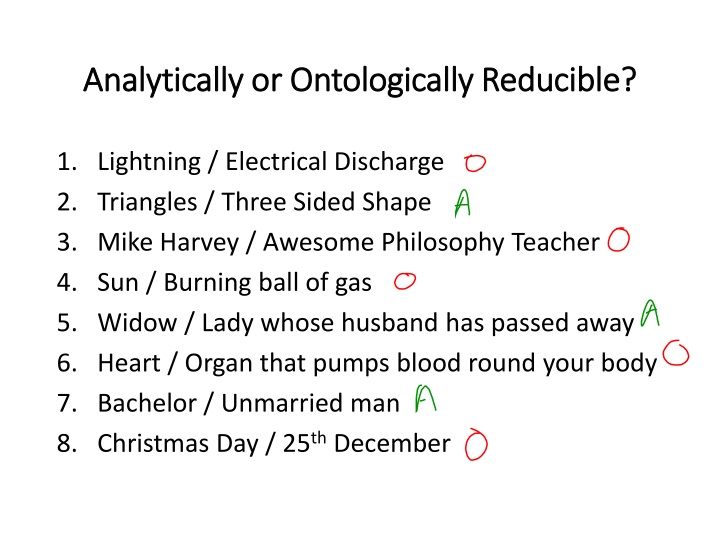

![[PDF⚡READ❤ONLINE] Zen Mind, Beginner's Mind: 50th Anniversary Edition](/thumb/20459/pdf-read-online-zen-mind-beginner-s-mind-50th-anniversary-edition.jpg)

